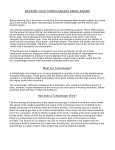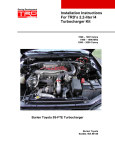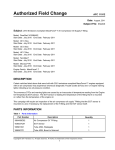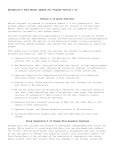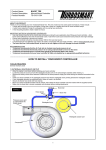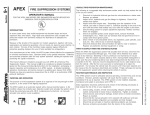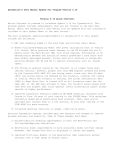Download Troubleshooting Tips – Turbocharger Oil Leaks
Transcript
Troubleshooting Tips – Turbocharger Oil Leaks A common problem encountered with turbocharger operations is the “turbocharger oil leak”. Often the assumption is made that the turbo is at fault. This can cause unnecessary maintenance to be performed. In the vast majority of cases the “oil leak” is not a turbo problem, rather it is caused by either improper turbo installation or engine maintenance. To fully understand what causes a turbocharger to leak oil and how to prevent it, we will cover: • • • • • • Oil inside the turbocharger Turbocharger Seals Check Valves Leaks at the compressor outlet Leaks at the turbine outlet Engine breathers OIL INSIDE THE TURBOCHARGER Engine oil under pressure enters the bearing housing from the oil inlet line. This oil passes between the bearing and wheel journal surfaces where, as a result of turbulence, air is mixed with the oil and is de-pressurized. This oil then flows either by gravity or scavenge pump through the oil drain line and into the engine sump. Anything which prevents this draining will cause the oil to build up in the bearing housing to a height above the oil seals. Under this condition, the oil will leak out into the compressor housing and/or the turbine housing past the piston ring seals. SEALS The main purpose of the seals at both the compressor and turbine ends of the center housing is to prevent the high pressure gasses from entering the center housing and then into the crankcase! The fact that the seals prevent oil from entering the housings is secondary. CHECK VALVES Check valves are sometimes installed into supply and drain lines of turbocharger oil systems to prevent oil from seeping by gravity (after engine shutdown) into the bearing housing. If the inlet or outlet check valves are faulty, all the oil that remains in the line will flow back into the bearing housing which can fill up to a point past the seals and cause the turbo to leak oil. The inlet check valve is usually the spring loaded ball and seat type. “Cracking pressures vary between 5-20 lbs”. If air flows immediately the valve is probably faulty. The outlet check valves usually have a spring loaded tensioned valve which will close with the absence of flowing oil. Sometimes the spring will break and allow the valve to remain open at all times. Check to see the valve will open and close by depressing the valve. OIL AT THE COMPRESSOR OUTLET The air filter, as it accumulates dirt, offers an increasing restriction, causing a pressure drop across it. A partial vacuum at the compressor inlet will result. If this condition continues for any length of time, it will cause oil to be drawn from the bearing housing and into the compressor housing and induction system. Service the air filter regularly to prevent this condition. Email: [email protected] www.autopowerhouse.com.au OIL AT THE TURBINE OUTLET Problems with the oil drain system can cause leaks to turbochargers as well. The majority of turbocharger oil leaks are recognized at the turbine (exhaust) outlet. This is because you will get an indication of oil coming out the tailpipe or leaking out the e parting lines of the center housing and turbine housing. If the center housing does not drain back to the sump properly, the level of oil in the bearing housing will exceed the height of the seals and leak. Check the following conditions and correct them m to eliminate the problem. Make certain that the turbo oil drain port is pointing down at no more than a 35 degree swing on either side of a vertical centerline; (see figure 1). On gravity drain systems (no scavenge pump) ensure the drain lines slopess downward its entire length, so there is no place for the oil to collect in the line. New installations especially should be double checked and any “sink traps” eliminated; (see figure 2). Make sure the turbocharger drain is connected to some unrestricted position on the engine above the level of oil in the sump/crankcase. If the oil drain enters the sump/crankcase below the oil level, it will cause the foamy oil to back up in the drain line and the bearing housing sump, thereby causing leakage; (see figure 3). Email: [email protected] autopowerhouse.com.au www.autopowerhouse autopowerhouse.com.au Finally, check the condition of the drain lines. Those made from a rubber-lined fabric covered hose may not cause any problems at all after running several years in one position. Even though the exterior of the hose looks fine, the rubber internal lining can become brittle. When replacing the turbocharger at any time, it is very possible that such a drain line could be disturbed and bent, causing internal cracking, and pieces of the brittle rubber to break off inside the drain line and partially obstruct the flow of oil. To prevent this from happening, always inspect the drain line when the turbocharger has been removed, and if in doubt; replace. ENGINE BREATHERS Oil leaks in the turbocharger may also, be the result of problems in the crankcase ventilation system. The vent or breather line may sometimes become clogged or restricted through engine operation. These conditions allow positive pressure to build up in the crankcase and restrict the oil from flowing down the drain hose and into the crankcase. This will cause oil to back up into the bearing housing and leak past the piston ring type seals. A BRAND NEW TURBOCHARGER MAY SMOKE FOR A SHORT PERIOD (PERHAPS 30 MINUTES) UNTIL ASSEMBLY LUBRICATION ON SEALS HAVE BEEN CONSUMED. We feel that if it were known that most turbocharger oil leaks are caused by non-turbocharger problems, much unnecessary maintenance, downtime and expense could be saved *** The information in this troubleshooting guide is presented for use only to aid properly qualified persons in the maintenance of the equipment covered herein. It no way replaces or changes the appropriate engine or turbocharger manufacturer’s service publications for the proper procedures on any maintenance performed. Email: [email protected] www.autopowerhouse.com.au



